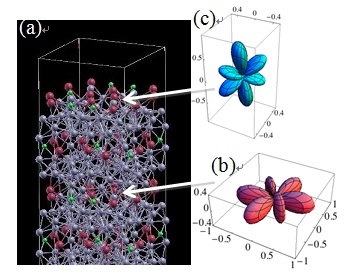(ESICMM-G8 Symposium on Next Generation Permanent Magnets, Tsukuba, 2015)
Electronic theory for the magnetic properties of Nd2Fe14B compounds
H. Tsuchiura1,2, T. Yoshioka1,2, and P. Novák3
1Department of Applied Physics, Tohoku University
2ESICMM
3Institute of Physics of ASCR, Cukrovarnická 10, 160, 00 Prague 6, Czech Republic
Abstract:
Because of the recent developments in energy-saving and renewable technology, there has been an emerging demand in improving the coercivity of Nd-Fe-B permanent magnets without using dysprosium to substitute part of neodymium. Thus theoretical understanding of the coercivity mechanisms of Nd-Fe-B is urgently needed. Although, in general, the coercivity mechanisms in the permanent magnets are very much complicated, it has been widely accepted that the large magnetic anisotropic energy due to the Nd ions is the dominant factor of the coercivity of Nd-Fe-B magnets. For deeper understanding of the mechanism, it is necessary to study the magnetic anisotropy due to the Nd ions from the viewpoint of crystal field theory. Several recent experimental studies have revealed that local atomic structures around the grain boundaries of sintered Nd-Fe-B magnets significantly affect their coercivity [1, 2]. Theoretically, on the basis of first-principles calculations, we have found that the crystal field parameters (CFP) A20 of Nd ions can be negative, implying the local in-plane anisotropy, if they are exposed on the (001) surface of the crystalline Nd2Fe14B, as shown in Fig. 1 (a) [3, 4]. We have also reported that such surface anisotropy anomaly may cause coercivity reduction of a single Nd2Fe14B particle by half of the anisotropy field HK, based on a simple micromagnetic-type simulation [5]. It is still unclear, however, whether this observation can give an explanation of the coercivity mechanism of bulk sintered Nd-Fe-B magnets.

Fig. 1: (a) The (001) surface of the crystalline Nd2Fe14B
structure, and (b) the 4f clouds of Nd ions away from the
surface and those at the surface.
In this talk, first we show the physical origin of the anomalous surface anisotropy by using newly developed CFP calculation technique, the so-called Wannierization method [6]. We find that the 4f clouds in Nd2Fe14B system are usually lie within the c-plane, as shown in Fig. 1 (b), but extend along the c-axis direction in the surface Nd ions (Fig. 1 (c)). We also show the results of higher-order CFPs based on the Wannierization method, and discuss the spin-reorientation phenomena and coercivity of a single Nd2Fe14B particle.
[1] H. Sepehri-Amin, T. Ohkubo, T. Shima, and K. Hono, Acta Mater. 60, 819 (2012).
[2] T. Fukagawa, T. Ohkubo, S. Hirosawa, and K. Hono, J. Magn. Magn. Mater. 322, 3346 (2010).
[3] H. Moriya, H. Tsuchiura, and A. Sakuma, J. Appl. Phys. 105, 07A740 (2009).
[4] S. Tanaka, H. Moriya, H. Tsuchiura, A. Sakuma, M. Diviš, and P. Novák, J. Appl. Phys. 109, 07A702 (2011).
[5] C. Mitsumata, H. Tsuchiura, and A. Sakuma, Appl. Phys. Exp. 4, 113002 (2011).
[6] P. Novák, K. Knížek, and J. Kuneš, Phys. Rev. B 87, 205139 (2013).

